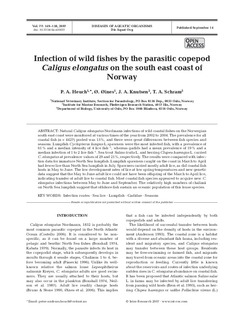Infection of wild fishes by the parasitic copepod Caligus elongatus on the south east coast of Norway
Journal article, Peer reviewed
Date
2007-09-14Metadata
Show full item recordCollections
- Articles [3009]
Original version
http://dx.doi.org/10.3354/dao01833Abstract
Natural Caligus elongatus Nordmann infections of wild coastal fishes on the Norwegian
south east coast were monitored at various times of the year from 2002 to 2004. The prevalence for all
coastal fish (n = 4427) pooled was 15%, and there were great differences between fish species and
seasons. Lumpfish Cyclopterus lumpus L.spawners were the most infected fish, with a prevalence of
61% and a median intensity of 4 lice fish–1, whereas gadids had a mean prevalence of 19% and a
median infection of 1 to 2 lice fish–1. Sea trout Salmo trutta L. and herring Clupea harengus L. carried
C. elongatus at prevalence values of 29 and 21%, respectively. The results were compared with infection
data for immature North Sea lumpfish. Lumpfish spawners caught on the coast in March to April
had fewer lice than North Sea lumpfish in July. Spawners carried mostly adult lice, as did coastal fish
hosts in May to June. The low development rates of lice at low spring temperatures and new genetic
data suggest that the May to June adult lice could not have been offspring of the March to April lice,
indicating transfer of adult lice to coastal fish. Most coastal fish species appeared to acquire new C.
elongatus infections between May to June and September. The relatively high numbers of chalimii
on North Sea lumpfish suggest that offshore fish sustain an oceanic population of this louse species.
